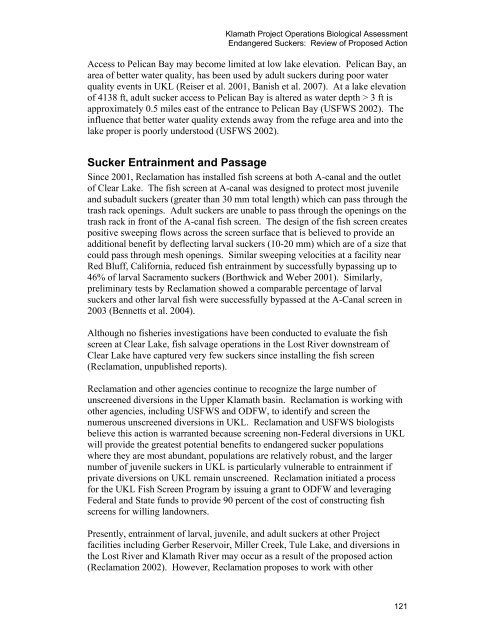Our new Biological Assessment is out - Klamath Basin Crisis
Our new Biological Assessment is out - Klamath Basin Crisis
Our new Biological Assessment is out - Klamath Basin Crisis
You also want an ePaper? Increase the reach of your titles
YUMPU automatically turns print PDFs into web optimized ePapers that Google loves.
<strong>Klamath</strong> Project Operations <strong>Biological</strong> <strong>Assessment</strong><br />
Endangered Suckers: Review of Proposed Action<br />
Access to Pelican Bay may become limited at low lake elevation. Pelican Bay, an<br />
area of better water quality, has been used by adult suckers during poor water<br />
quality events in UKL (Re<strong>is</strong>er et al. 2001, Ban<strong>is</strong>h et al. 2007). At a lake elevation<br />
of 4138 ft, adult sucker access to Pelican Bay <strong>is</strong> altered as water depth > 3 ft <strong>is</strong><br />
approximately 0.5 miles east of the entrance to Pelican Bay (USFWS 2002). The<br />
influence that better water quality extends away from the refuge area and into the<br />
lake proper <strong>is</strong> poorly understood (USFWS 2002).<br />
Sucker Entrainment and Passage<br />
Since 2001, Reclamation has installed f<strong>is</strong>h screens at both A-canal and the <strong>out</strong>let<br />
of Clear Lake. The f<strong>is</strong>h screen at A-canal was designed to protect most juvenile<br />
and subadult suckers (greater than 30 mm total length) which can pass through the<br />
trash rack openings. Adult suckers are unable to pass through the openings on the<br />
trash rack in front of the A-canal f<strong>is</strong>h screen. The design of the f<strong>is</strong>h screen creates<br />
positive sweeping flows across the screen surface that <strong>is</strong> believed to provide an<br />
additional benefit by deflecting larval suckers (10-20 mm) which are of a size that<br />
could pass through mesh openings. Similar sweeping velocities at a facility near<br />
Red Bluff, California, reduced f<strong>is</strong>h entrainment by successfully bypassing up to<br />
46% of larval Sacramento suckers (Borthwick and Weber 2001). Similarly,<br />
preliminary tests by Reclamation showed a comparable percentage of larval<br />
suckers and other larval f<strong>is</strong>h were successfully bypassed at the A-Canal screen in<br />
2003 (Bennetts et al. 2004).<br />
Although no f<strong>is</strong>heries investigations have been conducted to evaluate the f<strong>is</strong>h<br />
screen at Clear Lake, f<strong>is</strong>h salvage operations in the Lost River downstream of<br />
Clear Lake have captured very few suckers since installing the f<strong>is</strong>h screen<br />
(Reclamation, unpubl<strong>is</strong>hed reports).<br />
Reclamation and other agencies continue to recognize the large number of<br />
unscreened diversions in the Upper <strong>Klamath</strong> basin. Reclamation <strong>is</strong> working with<br />
other agencies, including USFWS and ODFW, to identify and screen the<br />
numerous unscreened diversions in UKL. Reclamation and USFWS biolog<strong>is</strong>ts<br />
believe th<strong>is</strong> action <strong>is</strong> warranted because screening non-Federal diversions in UKL<br />
will provide the greatest potential benefits to endangered sucker populations<br />
where they are most abundant, populations are relatively robust, and the larger<br />
number of juvenile suckers in UKL <strong>is</strong> particularly vulnerable to entrainment if<br />
private diversions on UKL remain unscreened. Reclamation initiated a process<br />
for the UKL F<strong>is</strong>h Screen Program by <strong>is</strong>suing a grant to ODFW and leveraging<br />
Federal and State funds to provide 90 percent of the cost of constructing f<strong>is</strong>h<br />
screens for willing landowners.<br />
Presently, entrainment of larval, juvenile, and adult suckers at other Project<br />
facilities including Gerber Reservoir, Miller Creek, Tule Lake, and diversions in<br />
the Lost River and <strong>Klamath</strong> River may occur as a result of the proposed action<br />
(Reclamation 2002). However, Reclamation proposes to work with other<br />
121










